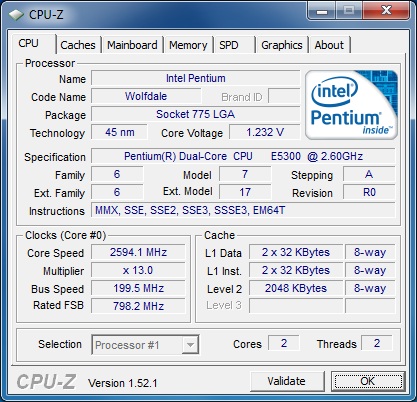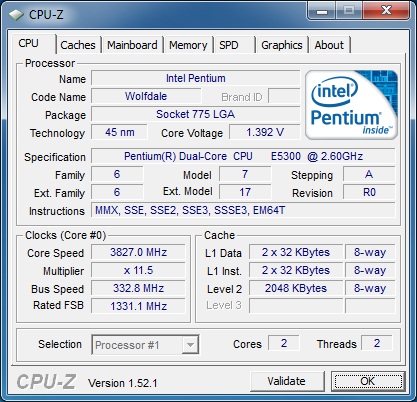System Builder Marathon, Dec. 2009: $700 Gaming PC
Overclocking
Overclocking
We have come to expect Pentium E5200 and E5300 processors to top out at a much lower FSB speed than other Wolfdale-based chips, such as the Core 2 Duo E7300 or E8400. Luckily, an 800 MHz FSB equates to a high available multiplier and the ability to exceed 4.0GHz core speed at FSB-1333. An apparent wall was reached at 340 MHz (FSB-1360) on this system, which then eliminated the need to later raise voltage settings normally associated with a high FSB overclock.
As we have often stated, overclocking is luck of the draw and results vary from chip to chip. The much higher voltage ID (VID) of this E5300 was an early indication that the processor would not scale as well as the 1.125V E5200 we received for the $600 gaming PC build back in May.
Jumping straight to FSB-1333 and a multiplier of nine, we began stability testing at each multiplier increment, finding that 3.33 GHz was fully stable at stock voltage, but a jump to 3.5 GHz failed to load Windows. Finding stability required a 50mV bump, and an additional 50mV bump at 3.66GHz meant voltage scaling for this Pentium’s core speed was running about 200 MHz behind the gem from back in May.
We pressed on by increasing the multiplier in half increments and bumping up the CPU voltage until finding stability. When all was said and done, this E5300 successfully completed a 20 minute stress test at 4.0GHz, but required a whopping 1.488V idle (1.456V load) to do so. This was more voltage than any of the E5200s I have tested required at this core speed, and above what we would utilize for long-term use, so no attempts were made to completely stability test the chip at this frequency.
After numerous presumably stable overclocks failed to pass a lengthy array of stress testing, tweaking time was running out and we settled on using 3.83 GHz at 1.424V idle (1.392V load). Further efforts after all performance testing had been completed found 3.9 GHz stability at 1.456V idle (1.424V load).
Overclocking with the DFI BI P45-T2RS was an interesting experience. On a positive note, the board rarely failed to post, and successfully recovered each time it did fail without the need to clear the CMOS jumper. The trouble we encountered was in the amount of time it took to dial in a fully stable overclock. Voltage scaling with this E5300 was unpredictable, as putting an hour into overclocked settings that eventually were found to be unstable chewed up a lot of time. Unfortunately, little time was left for maximizing the speed and timings of the system RAM, and no such luck was found when even booting at DDR2-1066, never mind passing Memtest 86+ stability testing.
Get Tom's Hardware's best news and in-depth reviews, straight to your inbox.
The full-featured Genie BIOS is packed with settings and voltages, and pressing F9 reveals additional adjustments normally reserved for enthusiast-class motherboards. I have little doubt that enough tweaking time would have brought out more potential from this system. The overclock we settled for, while maybe not ideal, did provide a fully-stable test environment.
And for those hesitant to dabble too much in the BIOS on their own, DFI even includes preconfigured profiles and an auto-boost system (ABS) for saving, loading, and sharing BIOS settings. The profile for FSB-800 chips was easily able to run our E5300 at 3.46 GHz (266 x 13), although it applied more CPU voltage than was necessary at such a speed.
Overclocking the two XFX Radeon HD 4870s was a painless and rewarding experience. Incremental increases to the GPU core and then the GDDR5 memory revealed that this pair of cards was capable of running at the maximum 790 MHz/1,100 MHz settings available in Catalyst Control Center. The graphics card fans were manually set to 100% from the start, but then lowered to 85% for final stability and performance testing.
-
shadowryche Must be something wrong with my ThermalTake Toughpower 750watt, because even that had trouble running a pair of Radeon 4870 512mb cards in crossfire under heavy load. And I only had two hard drives and one optical drive. The only other expansion card I ran was a Wireless N card.Reply -
noob2222 Wish there was an included SBM September in the charts, or at least a link to it. http://www.tomshardware.com/reviews/amd-gaming-pc,2424.html If the numbers are consistent, and seeing how W7 is slightly faster, the september build is a tad faster with less graphic power and $50 less in the build. With the exception of max resolution, and thats the graphics card difference doing the work.Reply
Add in the new AMD options, http://www.tomshardware.com/reviews/athlon-ii-x3,2452.html, wich takes the lead for the most part over the Phenom II x2 550, I am suprised you opted for the intel chip.
That is unless you plan on doing SBMs alternating wich manufacturer is used.
Athlon II 435 with 2 4870s would kill this build at the same price. -
qwertymac93 So we are back to an intel only marathon again. i guess it was silly of me to expect at least ONE system to have an amd cpu in it. it would have been interesting to see the athlon 620+ddr3 be put in the $700 pc, it would have been a nice "are 4 better then 2?" comparison with Septembers build. would have been nice to see dual 5750s in the $700 pc too, but availability and bla bla, i know. with all those modifications though, it would have been closer to a $800pc :(. On a side note, any thoughts on nzxt beta evo vs antec two hundred?Reply -
darthfett It seems to me that in a budget computer, you are not going to be paying huge amounts for a large monitor. Why use 2 graphics cards when one will do for a smaller monitor. Games these days are still pretty CPU heavy.Reply -
rdawise noob2222Wish there was an included SBM September in the charts, or at least a link to it. http://www.tomshardware.com/review ,2424.html If the numbers are consistent, and seeing how W7 is slightly faster, the september build is a tad faster with less graphic power and $50 less in the build. With the exception of max resolution, and thats the graphics card difference doing the work.Add in the new AMD options, http://www.tomshardware.com/review ,2452.html, wich takes the lead for the most part over the Phenom II x2 550, I am suprised you opted for the intel chip. That is unless you plan on doing SBMs alternating wich manufacturer is used.Athlon II 435 with 2 4870s would kill this build at the same price.Reply
You beat me to this.
Have to wonder why the author used a dead socket with no upgrade path. -
snorojr 5750 availability problem ???? you gottas be joking, i had no problem having my hd 5770 while the 5850 where nowhere findable. They could seriously have took the 57xx serie route and the 5750 and 5770 are doing very good in crossfire setup. Sometime with the big overclock margin they have, a pair 5770 can beat a pair of 4890 in crossfire.Reply -
pauldh noob2222Wish there was an included SBM September in the charts, or at least a link to it. http://www.tomshardware.com/review ,2424.html Last round’s data was left out of the charts because of the migration to Windows 7 and updated benchmark versions. However, a link to the September $650 PC was provided in the opening paragraph of the intro, and comparisons made throughout the data analysis.Reply
noob2222If the numbers are consistent, and seeing how W7 is slightly faster, the september build is a tad faster with less graphic power and $50 less in the build. With the exception of max resolution, and thats the graphics card difference doing the work. The gaming benchmarks are especially comparable, and yes as we note, this rig was behind the Sep PII at the lower settings/resolution and had a graphics advantage taking over at the higher settings. But note, the September build was MORE expensive when this system was ordered, not $50 cheaper. Had we opted to use up this whole “price adjustment” budget and build a $750 machine, a kit of CAS 5 DDR2 (like the AMD build) would have done this one wonders, even more so than expected.
noob2222I am suprised you opted for the intel chip. That is unless you plan on doing SBMs alternating wich manufacturer is used. Bingo; Notice all AMD last round even at the high end, and all Intel this round, even at the low end. Something we wanted to try, but will not be continuing.
noob2222Athlon II 435 with 2 4870s would kill this build at the same price. That is exactly the plan for next round, although getting a pair of 4870s will likely not be an option. At $87, pairing with an aftermarket cooler will then raise the CPU+cooler budget a bit over the $102 from Sep, or the $92 from December. One of the goals set for this Intel rig back in September was to keep an equal CPU budget to last round, and if possible put the extra money into a graphics step up, although more along the lines of 4850 1GB not 4870’s. There was nothing exciting to challenge the PII at stock clocks, instead the focus was on an aftermarket cooler and better OC. Unfortunately this E5300 was a bit of a dud compared to previous E5200’s.
I wouldn’t say the 435 would kill these past two rigs though. I suspect it will trade blows in the apps, and likely take a few nice wins(at low res) in the games.



